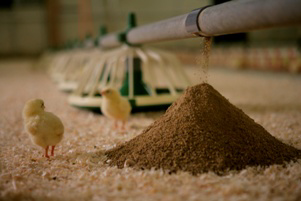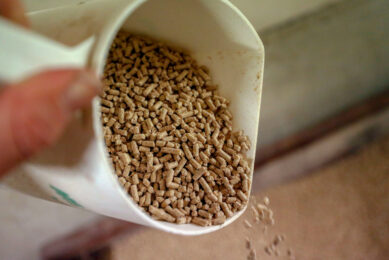Benefits of coarse particles on broiler gizzards

Diets with large particle size benefit the performance of broilers. The particles promote gizzard development and activity, and, consequently, feed is retained longer in the gizzard and its particles are more uniform when they pass to the small intestine, favouring their digestion.
By Antônio Mário Penz Junior and Daniel Gonçalves Bruno, Cargill Animal Nutrition.
In poultry, the narrow opening of the pylorus prevents the passage of large particles to the small intestine from the gizzard, where they remain, stimulating its activity. Gizzard adequate development promotes better gastric motility, increases gastro duodenal reflux, enhancing the contact of the digesta with pepsin and hydrochloric acid in the gizzard, and hence, protein digestibility, and reduces the predisposition of the entrance of pathogens in the intestine, as well as the risk of coccidiosis. Moreover, large particles require less energy during feed apprehension, as birds require fewer pecks to ingest the same amount of feed.
Diets with small particle size significantly increase digesta viscosity, which has a negative impact on nutrient digestibility. It is recommended the inclusion of at least 20-30% cereal particles larger than 1 mm or the inclusion of at least 3% fibre in the diet in order to stimulate gizzard activity and to maximise broiler performance. Additional advantages of diets with large particles are energy savings in grinding in the feed mill – 27% energy savings may be obtained when sieve size in hammer mills increase from 4.76 to 6.35 mm.
Nutrient retention and poultry performance
In a literature review it was found that large particles in mash diets promoted broiler performance. However, when pelleted diets were fed, the effect of particle size on performance was controversial. Other factors, in addition to particle size and feed physical form, may influence performance, such as age, as very young broilers may find it difficult to ingest large particles due to their small beak size and also because their gizzard is not sufficiently developed to efficiently grind large cereal particles.
Also, broiler performance can be affected by particle size uniformity, as high variety in particle sizes size allows birds to select the diet, spending more time eating as compared with more uniform diets.
Better performance of broilers fed whole wheat grains is explained by gizzard stimulation and slow feed passage rate, which would prevent that starch overload. Coarse particles may cause a considerable increase in gizzard size, thereby increasing energy requirements for gizzard maintenance, with consequent broiler performance impairment. Moreover, the benefit promoted by the consumption of medium particles may be explained by the fact that it does not allow particle selection and reduce passage time by the intestinal tract. Also, the effect of particle size may be related to the type of feedstuff evaluated.
The better performance of broilers fed pelleted diets relative to those fed mash diets is well known in poultry production and is associated to higher AME content, better protein digestibility, as well as better intestinal function, as shown by increased villi height and villi height to crypt depth ratio. This improvement in performance brought about by pelleting is more evident in fast growing poultry. Pelleting compensates the effects of dietary small particle sizes, because pelleting makes the frequency of particle size distribution uniform among pellets.
Effect of mash conditioning
One of the factors that influence pellet quality is conditioning temperature following a study on the effect of different conditioning temperatures of diets containing different grains on broiler performance. In broilers fed wheat based diets, increasing conditioning temperatures negatively affected weight gain and nitrogen and starch ileal digestibility. On the other hand, broilers fed corn diets presented higher weight gain and better nitrogen and starch ileal digestibility when conditioning temperatures were 60°C and 90°C compared with 75°C. Independently of cereal type, feed conversion ratio worsened as conditioning temperature increased from 60°C to 75 and 90°C. These results may be partially explained by differences in AME intake and increase in viscosity. Another study found that in corn and soybean meal based diets, high conditioning temperatures (82.2°C vs. 93.3°C) improved grower phase broiler performance, which seems to be associated with harder pellets. Earlier it was found that soft pellets (obtained by adding water during pelleting) resulted in worse performance and nutrient retention relative to hard pellets (obtained by adding a commercial binder) in growing broilers.
Inclusion of whole grains
The practice of including whole grains in broiler diets is used in some countries to reduce diet transport and processing costs. It is hypothesised that the inclusion of whole cereal grains would improve digestion efficiency. The higher starch digestibility and AMEn content in diets with whole grains may be associated with better gizzard development, higher digesta retention time in the gizzard, or gizzard pH reduction, which would inhibit bacteria growth and increase the efficiency of protein digestion. Also, better wheat starch digestibility may explain the better performance of broilers fed whole wheat grains, as amylase and bile secretion increases possibly due to higher gizzard activity and mediated by higher pancreas activity. These observations are consistent with the improvement in AMEn content and starch digestibility both in the ileum and in the excreta when whole wheat grains are added to broiler diets. When evaluating the inclusion of whole grains of wheat, oats, and barley in broiler diets, weight gain and feed intake reduction with the inclusion of whole grain was observed. However, feed conversion ratio was only affected after 44% whole wheat and 33% whole oats and barley were included in the diet. It was also observed that broilers fed whole grains had a better feed conversion ratio and reduce water intake relative to those fed pellets with ground wheat. The birds fed whole wheat had better gizzard development, and a trend to present lower counts of pathogenic bacteria in the intestine.
Microbial population in the gastrointestinal tract
When compared with pelleted diets, mash diets, particularly those containing larger particles, are retained longer in the gizzard as they require further grinding. This stimulates the secretion of hydrochloric acid by the proventriculus, and consequently the pH of the gizzard of broilers fed mash diets is lower relative to those fed pelleted diets. The increase in feed intake promoted by pelleted diets may mask this pH reduction due to their buffering effect. Also, lower gizzard pH may enhance protein digestion as it stimulates pepsin secretion. Also, it should be considered that better gizzard activity, as it promotes nutrient digestibility, therefore may leave less nutrients available for bacterial proliferation in the intestine, with beneficial microbiological consequences. Mortality of Salmonella spp collected from the gizzard was higher in broilers fed mash diets with large particle sizes than those fed diets with small particle size, whereas no mortality differences were found when pelleted diets were offered, independently of particle size. But a lower presence of lactobacilli and of Clostridium perfringens were detected in the intestine of broilers fed pelleted diets, possibly due to the lower availability of non-digested nutrients.
| Benefits of large particles • Large particle size promotes gizzard development and activity. The particles stay longer retained in the gizzard and pass to duodenum more uniform. This favours ingredient digestibility and nutrient absorption due to the reduction on digesta viscosity and to the increase of gastro duodenal reflux. • Large particle size reduces the predisposition of pathogens to enter in the intestine and requires less apprehension energy than small particles that can be used to tissue accretion. • At the feed mill, large particle size grinding saves energy expenditure, making the process cheaper. • The consequence of coarse particle size is a performance improvement of broilers. A general figure for minimum diet particle size for broilers is around 1 mm. This is less effective when diets are pelleted. • Pelleted diets are more efficient than mash diets due higher dietary density, better starch digestibility due to chemical changes due to pelleting process, higher feed intake, reduction on feed wastage and energy use for feed consumption and better intestinal function. |
This article is an edited version of “Impacts of feed texture and particle size on broiler and layer feeding patterns”, by Penz and Gonçalves, presented at the World´s Poultry Congress 5 – 9 August 2012 in Salvador, Bahia, Brazil.












